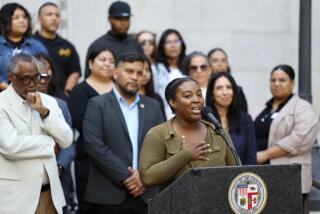Obama needs a bigger New Deal
- Share via
President-elect Barack Obama said last week that his multibillion-dollar stimulus package would kick-start the economy by essentially creating a New New Deal.
“We will put Americans to work in new jobs that pay well and can’t be outsourced -- jobs building solar panels and wind turbines; constructing fuel-efficient cars and buildings; and developing the new energy technologies that will lead to even more jobs, more savings, and a cleaner, safer planet in the bargain,” he said.
That’s great, as far as it goes. Problem is, it doesn’t go far enough.
Obama’s vision for public-works spending on a scale not seen since the Great Depression represents a unique opportunity to address fundamental inequities in American society and remedy problems that plague Southern California and other metropolitan areas.
Along with a focus on green technology, the billions in stimulus cash should have two key goals: a massive improvement of the nation’s public-transportation infrastructure and a commitment to housing for workers who can’t afford to be part of the communities they serve.
Darling Quijada, 33, a nurse at California Hospital Medical Center in downtown Los Angeles, wanted her own little piece of the American dream. She wanted a house big enough for a young family to grow into.
But when she and her husband, who also works as a nurse at the hospital, looked around L.A., they came up empty.
Sure, there were places within their price range, but they considered them all either too small or too far from high-ranking schools and other resources.
They ended up buying a 3,000-square-foot house in Palmdale for $380,000. “There was no way we could have afforded a home like that in L.A.,” Quijada said.
The downside is that Quijada must leave for work each morning around 5 and typically doesn’t return home until about 9:30 at night. The 60-mile commute takes roughly two hours each way.
“I would love to be closer to my job,” Quijada said. “The drive is very long. But we decided we didn’t want to sacrifice on our home.”
Of course, $380,000 will go farther these days than it did when Quijada was house-hunting about four years ago. As of late November, Southern California’s median home price had plunged nearly 35% from a year before, to $285,000 -- its first dip below $300,000 since 2003.
But real estate experts say the median price is misleading because it reflects the record number of foreclosed properties now on the market, which means it’s been skewed by a whole lot of places in the Inland Empire and similarly far-flung locales.
The November median home price in L.A. County was $340,000. In Orange County it was $400,000.
And the experts say a home near a top-scoring public school can run at least twice the median level.
For renters, the cost of apartments has come down in recent months, but affordable dwellings remain elusive for many working-class people.
To remedy this, a coalition of L.A. business groups presented a plan last week that would seek to increase the number of apartments and condos for working people in the city by relaxing rules for building height and parking.
The plan, drafted by the Central City Assn., envisions increased density near Metro stations and widely used bus routes as part of an effort to allow people to live closer to their jobs.
“The basic premise is that we need affordable housing all over the city, not just a few places,” said Carol Schatz, president of the coalition.
This is a laudable goal. But cramming more people into relatively small spaces without simultaneously improving L.A.’s pitiful public-transit system seems like a surefire recipe for increased congestion.
After all, you’ll still need wheels to survive. Only now you’d have nowhere to park.
If Obama wants to put a big pile of borrowed money to long-term use, he should dedicate the bulk of it to giving Americans a viable alternative to their cars.
That means subways or monorails in urban areas and high-speed rail lines between cities.
This would create jobs, protect the environment and significantly improve both living standards and productivity.
At the same time, funds should be devoted to providing tax breaks to private employers that help workers live within, say, 10 miles of their jobs. (One possibility: subsidies for rent or mortgage payments. Another: corporate dorms; the Japanese have been doing it for decades.)
Stimulus cash also should be used to provide tax credits to teachers, nurses, firefighters and police officers so they can live closer to the areas they serve.
Yes, local politicians should look at proposals like what the Central City Assn. has come up with -- these problems are too big to leave to the public sector alone. But private-sector initiatives should be part of a larger plan to completely reinvent American society.
When President Eisenhower green-lighted construction of the interstate highway system in the 1950s, he had a vision of Americans zooming from their happy homes in the suburbs to their well-paying jobs in the city. It didn’t turn out that way for most people.
Obama now has a chance to begin fixing things while rescuing the economy. New jobs for making solar panels and wind turbines sound nifty.
But we can do so much more.
--
David Lazarus’ column runs Wednesdays and Sundays.
Send your tips or feedback to [email protected].
--
latimes.com/lazarus/transportation
Weigh in
Should public transportation be a top priority for the
Obama administration?
More to Read
Sign up for Essential California
The most important California stories and recommendations in your inbox every morning.
You may occasionally receive promotional content from the Los Angeles Times.











